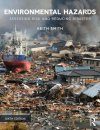![Environmental Hazards Environmental Hazards]()
Click to have a closer look
About this book
Contents
Customer reviews
Biography
Related titles
About this book
The much expanded sixth edition of Environmental Hazards provides a fully up-to-date overview of all the extreme events that threaten people and what they value in the 21st century. It integrates cutting-edge material from the physical and social sciences to illustrate how natural and human systems interact to place communities of all sizes, and at all stages of economic development, at risk. It also explains in detail the various measures available to reduce the ongoing losses to life and property. Part One of this established textbook defines basic concepts of hazard, risk, vulnerability and disaster. Attention is given to the evolution of theory, to the scales and patterns of disaster impact and to the optimum management strategies needed to minimize the future impact of damaging events. Part Two employs a consistent chapter structure to demonstrate how individual hazards, such as earthquakes, severe storms, floods and droughts, plus biophysical and technological processes, create distinctive impacts and challenges throughout the world. The ways in which different societies can make positive responses to these threats are placed firmly in the context of sustainable development and global environmental change.
This extensively revised edition includes:
- A new concluding chapter that summarizes the globalization of hazard and critically examines the latest perspectives on climate-related disasters
- Fresh perspectives on the reliability of disaster data, disaster risk reduction, severe storms, droughts and technological hazards
- More boxed sections with a focus on both generic issues and the lessons to be learned from a carefully selected range of recent extreme events
- An annotated list of key resources, including further reading and relevant websites, for all chapters
- 183 diagrams, now in full colour, over 30 colour photographs and more than 1,000 references to some of the most significant and recent published material
Environmental Hazards is a clearly-written, authoritative account of the causes and consequences of the extreme natural and technological processes that cause death and destruction across the globe. It draws on the latest research findings to guide the reader from common problems, theories and policies to explore practical, real-world situations and solutions. This carefully structured and balanced book captures the complexity and dynamism of environmental hazards and has become essential reading for students of every kind seeking to understand this most important contemporary issue.
Contents
Part One: The Nature of Hazard
1. Hazard in the Environment
2. Dimensions of Disaster
3. Complexity, Sustainablity and Vulnerability
4. Risk Assessment and Management
5. Reducing the Impacts of Disaster
Part Two: The Experience and Reduction of Hazard
6. Tectonic Hazards - Earthquakes and Tsunamis
7. Tectonic Hazards - Volcanoes
8. Landslide and Avalance Hazards
9. Severe Storm Hazards
10. Weather Extremes, Disease Epidemics and Wildfires
11. Hydrological Hazards - Floods
12. Hydrological Hazards - Droughts
13. Technological Hazards
14. Environmental Hazards in a Changing World
Bibliography
Index
Customer Reviews
Biography
Keith Smith is Emeritus Professor of Environmental Science and former Dean of Natural Sciences at the University of Stirling. He is a Fellow of the Royal Society of Edinburgh.



































